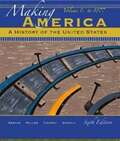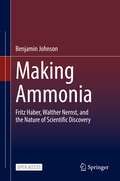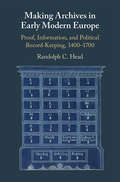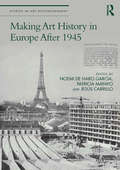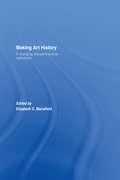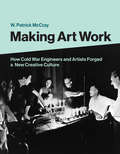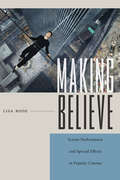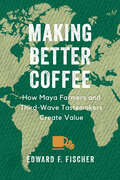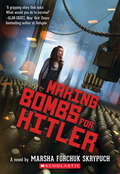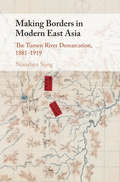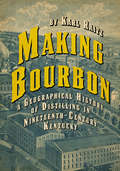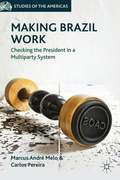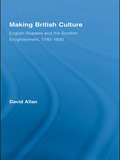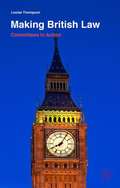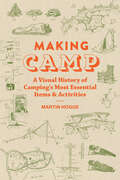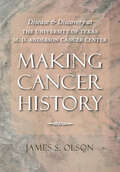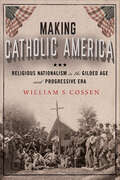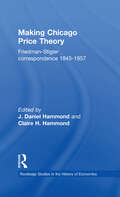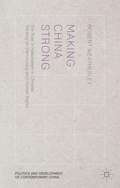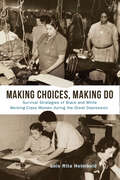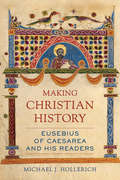- Table View
- List View
Making America: A History of the United States, Volume 1: To 1877, Brief
by Carol Berkin Christopher Miller Robert Cherny James Gormly Douglas EgertonMAKING AMERICA: A HISTORY OF THE UNITED STATES, BRIEF SIXTH EDITION, presents history as a dynamic process shaped by human expectations, difficult choices, and often the surprising consequences. With this focus on history as a process, MAKING AMERICA encourages readers to think historically and to develop into citizens who value the past. The clear chronology, straightforward narrative, and strong thematic structure emphasize communication over intimidation and appeal to readers of varied learning levels. The Brief Sixth Edition retains a hallmark feature of the MAKING AMERICA program: pedagogical tools that allow readers to master complex material and enable them to develop analytical skills. Every chapter has chapter outlines, chronologies, focus questions, and on-page glossaries (defining both key terms and general vocabulary) to provide guidance throughout the text; the open, inviting design allows readers to access and use pedagogy to improve learning. A wealth of images throughout provides a visual connection to the past, with captions that help readers analyze the subject of the painting, photograph, or artifact from an historical point of view. ""Investigating America"" gets to the heart of learning history: reading and analyzing primary sources. A new feature, ""In The Wider World"" introduces a global perspective for each chapter. In addition, a new map program provides clear, visually engaging maps with globe insets to put the map in a global context. Available in the following split options: MAKING AMERICA, Brief Sixth Edition Complete, Volume 1: To 1877, and Volume 2: Since 1865.
Making Ammonia: Fritz Haber, Walther Nernst, and the Nature of Scientific Discovery
by Benjamin JohnsonThis Open Access book discusses the progress of science and the transfer of scientific knowledge to technological application. It also identifies the factors necessary to achieve this progress. Based on a case study of the physical chemist Fritz Haber's discovery of ammonia synthesis between 1903 and 1909, the book places Haber's work in historical and scientific (physicochemical) context. The scientific developments of the preceding century are framed in a way that emphasizes the confluence of knowledge needed for Haber's success. Against this background, Haber's work is presented in detail along with the indispensable contributions of his colleague, the physical chemist, Walter Nernst, and their assistants. The detailed accounts of scientific advancement remind us of the physical basis on which our scientific theories and ideas are built. Without this reminder we often forget how complex, and how beautiful achievements in science can be.
Making Ancient Cities
by Andrew T. Creekmore III Kevin D. FisherThis volume investigates how the structure and use of space developed and changed in cities, and examines the role of different societal groups in shaping urbanism. Culturally and chronologically diverse case studies provide a basis to examine recent theoretical and methodological shifts in the archaeology of ancient cities. The book's primary goal is to examine how ancient cities were made by the people who lived in them. The authors argue that there is a mutually constituting relationship between urban form and the actions and interactions of a plurality of individuals, groups, and institutions, each with their own motivations and identities. Space is therefore socially produced as these agents operate in multiple spheres.
Making Archives in Early Modern Europe: Proof, Information, and Political Record-Keeping, 1400–1700
by Randolph C. HeadEuropean states were overwhelmed with information around 1500. Their agents sought to organize their overflowing archives to provide trustworthy evidence and comprehensive knowledge that was useful in the everyday exercise of power. This detailed comparative study explores cases from Lisbon to Vienna to Berlin in order to understand how changing information technologies and ambitious programs of state-building challenged record-keepers to find new ways to organize and access the information in their archives. From the intriguing details of how clerks invented new ways to index and catalog the expanding world to the evolution of new perspectives on knowledge and power among philologists and historians, this book provides illuminating vignettes and revealing comparisons about a core technology of governance in early modern Europe. Enhanced by perspectives from the history of knowledge and from archival science, this wide-ranging study explores the potential and the limitations of knowledge management as media technologies evolved.
Making Art History in Europe After 1945 (Studies in Art Historiography)
by Noemi de Haro García Patricia Mayayo Jesús CarrilloThis book analyses the intermeshing of state power and art history in Europe since 1945 and up to the present from a critical, de-centered perspective. Devoting special attention to European peripheries and to under-researched transnational cultural political initiatives related to the arts implemented after the end of the Second World War, the contributors explore the ways in which this relationship crystallised in specific moments, places, discourses and practices. They make the historic hegemonic centres of the discipline converse with Europe’s Southern and Eastern peripheries, from Portugal to Estonia to Greece. By stressing the margins’ point of view this volume rethinks the ideological grounds on which art history and the European Union have been constructed as well as the role played by art and culture in the very concept of ‘Europe.’
Making Art History: A Changing Discipline and its Institutions
by Elizabeth C. MansfieldMaking Art History is a collection of essays by contemporary scholars on the practice and theory of art history as it responds to institutions as diverse as art galleries and museums, publishing houses and universities, school boards and professional organizations, political parties and multinational corporations. The text is split into four thematic sections, each of which begins with a short introduction from the editor, the sections include: Border Patrols, addresses the artistic canon and its relationship to the ongoing 'war on terror', globalization, and the rise of the Belgian nationalist party. The Subjects of Art History, questions whether 'art' and 'history' are really what the discipline seeks to understand. Instituting Art History, concerns art history and its relation to the university and raises questions about the mission, habits, ethics and limits of university today. Old Master, New Institutions, shows how art history and the museum respond to nationalism, corporate management models and the 'culture wars'.
Making Art Panamerican: Cultural Policy and the Cold War
by Claire F. FoxAmong the buildings on the National Mall in Washington, D.C., only the Pan American Union (PAU) houses an international organization. The first of many anticipated &“peace palaces&”constructed in the early twentieth century, the PAU began with a mission of cultural diplomacy, and after World War II its Visual Arts Section became a leader in the burgeoning hemispheric arts scene, proclaiming Latin America&’s entrée into the international community as it forged connections between a growing base of middle-class art consumers on one hand and concepts of supranational citizenship and political and economic liberalism on the other.Making Art Panamerican situates the ambitious visual arts programs of the PAU within the broader context of hemispheric cultural relations during the cold war. Focusing on the institutional interactions among aesthetic movements, cultural policy, and viewing publics, Claire F. Fox contends that in the postwar years, the PAU Visual Arts Section emerged as a major transfer point of hemispheric American modernist movements and played an important role in the consolidation of Latin American art as a continental object of study. As it traces the careers of individual cultural policymakers and artists who intersected with the PAU in the two postwar decades—such as Concha Romero James, Charles Seeger, José Gómez Sicre, José Luis Cuevas, and Rafael Squirru—the book also charts the trajectories and displacements of sectors of the U.S. and Latin American intellectual left during a tumultuous interval that spans the Mexican Revolution, the Spanish Civil War, the New Deal, and the early cold war. Challenging the U.S. bias of conventional narratives about Panamericanism and the postwar shift in critical values from realism to abstraction, Making Art Panamerican illuminates the institutional dynamics that helped shape aesthetic movements in the critical decades following World War II.
Making Art Work: How Cold War Engineers and Artists Forged a New Creative Culture
by W. Patrick MccrayThe creative collaborations of engineers, artists, scientists, and curators over the past fifty years.Artwork as opposed to experiment? Engineer versus artist? We often see two different cultural realms separated by impervious walls. But some fifty years ago, the borders between technology and art began to be breached. In this book, W. Patrick McCray shows how in this era, artists eagerly collaborated with engineers and scientists to explore new technologies and create visually and sonically compelling multimedia works. This art emerged from corporate laboratories, artists' studios, publishing houses, art galleries, and university campuses. Many of the biggest stars of the art world--Robert Rauschenberg, Yvonne Rainer, Andy Warhol, Carolee Schneemann, and John Cage--participated, but the technologists who contributed essential expertise and aesthetic input often went unrecognized.
Making Believe: Screen Performance and Special Effects in Popular Cinema
by Lisa BodeIn the past twenty years, we have seen the rise of digital effects cinema in which the human performer is entangled with animation, collaged with other performers, or inserted into perilous or fantastic situations and scenery. Making Believe sheds new light on these developments by historicizing screen performance within the context of visual and special effects cinema and technological change in Hollywood filmmaking, through the silent, early sound, and current digital eras. Making Believe incorporates North American film reviews and editorials, actor and crew interviews, trade and fan magazine commentary, actor training manuals, and film production publicity materials to discuss the shifts in screen acting practice and philosophy around transfiguring makeup, doubles, motion capture, and acting to absent places or characters. Along the way it considers how performers and visual and special effects crew work together, and struggle with the industry, critics, and each other to define the aesthetic value of their work, in an industrial system of technological reproduction. Bode opens our eyes to the performing illusions we love and the tensions we experience in wanting to believe in spite of our knowledge that it is all make believe in the end.
Making Better Coffee: How Maya Farmers and Third Wave Tastemakers Create Value
by Edward F. FischerAn anthropologist uncovers how "great coffee" depends not just on taste, but also on a complex system of values worked out among farmers, roasters, and consumers. What justifies the steep prices commanded by small-batch, high-end Third Wave coffees? Making Better Coffee explores this question, looking at highland coffee farmers in Guatemala and their relationship to the trends that dictate what makes "great coffee." Traders stress material conditions of terroir and botany, but just as important are the social, moral, and political values that farmers, roasters, and consumers attach to the beans. In the late nineteenth century, Maya farmers were forced to work on the large plantations that colonized their ancestral lands. The international coffee market shifted in the 1990s, creating demand for high-altitude varietals—plants suited to the mountains where the Maya had been displaced. Edward F. Fischer connects the quest for quality among U.S. tastemakers to the lives and desires of Maya producers, showing how profits are made by artfully combining coffee's material and symbolic attributes. The result is a complex story of terroir and taste, quality and craft, justice and necessity, worth and value.
Making Bombs for Hitler
by Marsha Forchuk SkrypuchLida thought she was safe. Her neighbors wearing the yellow star were all taken away, but Lida is not Jewish. She will be fine, won't she?But she cannot escape the horrors of World War II. Lida's parents are ripped away from her and she is separated from her beloved sister, Larissa. The Nazis take Lida to a brutal work camp, where she and other Ukrainian children are forced into backbreaking labor. Starving and terrified, Lida bonds with her fellow prisoners, but none of them know if they'll live to see tomorrow. When Lida and her friends are assigned to make bombs for the German army, Lida cannot stand the thought of helping the enemy. Then she has an idea. What if she sabotaged the bombs. . . and the Nazis? Can she do so without getting caught?And if she's freed, will she ever find her sister again?This pulse-pounding novel of survival, courage, and hope shows us a lesser-known piece of history -- and is sure to keep readers captivated until the last page.
Making Borders in Modern East Asia: Tumen River Demarcation, 1881-1919
by Nianshen SongUntil the late nineteenth century, the Chinese-Korean Tumen River border was one of the oldest, and perhaps most stable, state boundaries in the world. Spurred by severe food scarcity following a succession of natural disasters, from the 1860s, countless Korean refugees crossed the Tumen River border into Qing-China's Manchuria, triggering a decades-long territorial dispute between China, Korea, and Japan.<P><P> This major new study of a multilateral and multiethnic frontier highlights the competing state- and nation-building projects in the fraught period that witnessed the Sino-Japanese War, the Russo-Japanese War, and the First World War. The power-plays over land and people simultaneously promoted China's frontier-building endeavours, motivated Korea's nationalist imagination, and stimulated Japan's colonialist enterprise, setting East Asia on an intricate trajectory from the late-imperial to a situation that, Song argues, we call modern.<P> Examines the making of modern China, Korea, and Japan through trans-regional, local, and competitive perspectives.<P> Rethinks the meaning territorial, ethnic, racial, and national boundaries.<P> Provides a historical perspective on international relations in twentieth-century East Asia.
Making Bourbon: A Geographical History of Distilling in Nineteenth-Century Kentucky
by Karl Raitz“Raitz examines the rich story of distilling in its Kentucky heartland and traces its maturation from a local craft to an enduring industry.” —William Wyckoff, author of How to Read the American WestWhile other industries chase after the new and improved, bourbon makers celebrate traditions that hearken back to an authentic frontier craft. Distillers enshrine local history in their branding and time-tested recipes, and rightfully so. Kentucky’s unique geography shaped the whiskeys its settlers produced, and for more than two centuries, distilling bourbon fundamentally altered every aspect of Kentucky’s landscape and culture.Making Bourbon: A Geographical History of Distilling in Nineteenth-Century Kentucky illuminates how the specific geography, culture, and ecology of the Bluegrass converged and gave birth to Kentucky’s favorite barrel-aged whiskey. Expanding on his fall 2019 release Bourbon’s Backroads, Karl Raitz delivers a more nuanced discussion of bourbon’s evolution by contrasting the fates of two distilleries in Scott and Nelson Counties. In the nineteenth century, distilling changed from an artisanal craft practiced by farmers and millers to a large-scale mechanized industry. The resulting infrastructure—farms, mills, turnpikes, railroads, steamboats, lumberyards, and cooperage shops—left its permanent mark on the land and traditions of the commonwealth. Today, multinational brands emphasize and even construct this local heritage. This unique interdisciplinary study uncovers the complex history poured into every glass of bourbon.“A gem. The depth of Raitz’s research and the breadth of his analysis have produced a masterful telling of the shift from craft to industrial distilling. And in telling us the story of bourbon, Raitz also makes a terrific contribution to our understanding of America's nineteenth-century economy.” —David E. Hamilton, author of From New Day to New Deal
Making Brazil Work
by Carlos Pereira Marcus André MeloThis book offers the first conceptually rigorous analysis of the political and institutional underpinnings of Brazil's recent rise. Using Brazil as a case study in multiparty presidentialism, the authors argue that Brazil's success stems from the combination of a constitutionally strong president and a robust system of checks and balances.
Making British Culture: English Readers and the Scottish Enlightenment, 1740–1830 (Routledge Studies in Cultural History)
by David AllanMaking British Culture explores an under-appreciated factor in the emergence of a recognisably British culture. Specifically, it examines the experiences of English readers between around 1707 and 1830 as they grappled, in a variety of circumstances, with the great effusion of Scottish authorship – including the hard-edged intellectual achievements of David Hume, Adam Smith and William Robertson as well as the more accessible contributions of poets like Robert Burns and Walter Scott – that distinguished the age of the Enlightenment.
Making British Defence Policy: Continuity and Change (Routledge Advances in Defence Studies)
by Robert SelfThis book explores the process by which defence policy is made in contemporary Britain and the institutions, actors and conflicting interests which interact in its inception and continuous reformulation. Rather than dealing with the substance of defence policy, this study focuses upon the institutional actors involved in this process. This is a subject which has commanded far more interest from public, Parliament, government and the armed forces since the protracted, bloody and ultimately unsuccessful British military involvement in Iraq and Afghanistan. The work begins with a discussion of two contextual factors shaping policy. The first relates to the impact of Britain’s ‘special relationship’ with the United States over defence and intelligence matters, while the second considers the impact of Britain’s relatively disappointing economic performance upon the funding of British defence since 1945. It then goes on to explore the role and impact of all the key policy actors, from the Prime Minister, Cabinet and core executive, to the Ministry of Defence and its relations with the broader ‘Whitehall village’, and the Foreign Office and Treasury in particular. The work concludes by examining the increasing influence of external policy actors and forces, such as Parliament, the courts, political parties, pressure groups and public opinion. This book will be of much interest to students of British defence policy, security studies, and contemporary military history.
Making British Law: Committees in Action
by Louise ThompsonLaws are essential to the lives of all British citizens and crucial to the survival of British Governments. This book follows the work of House of Commons bill committees as they scrutinise legislation and reveals the hidden depths of law making in the British Parliament.
Making Camp: A Visual History of Camping's Most Essential Items and Activities
by Martin HogueA visual exploration and history of one of America's favorite pastimes.Car camping, hike-in tent camping, bivouacking, mountaineering, RV camping, glamping, back yard camping . . . whatever your style, outdoor adventure awaits! For camping enthusiasts, this fascinating (and packable) volume holds a comprehensive look at the origins of the practice and the ways that bring all these enthusiasts together.From the early days of recreational camping in the late nineteenth century through the multitude of modern camping options available today, Making Camp explores the history and evolution of the popular activity through the lens of its most important and familiar components: the campsite, the campfire, the picnic table, the map, the tent, the sleeping bag, as well as the oft invisible systems for delivering water and managing trash.Find out how early nineteenth century German peasants fashioned rudimentary sleeping bags by burrowing into bags full of leaves for the night. Look back over several millennia to learn about the progression of tents from animal skins, goat's hair, and heavy canvas to featherweight nylon. Learn about the ways in which the skills to build and maintain a campfire have been displaced by the portable gas stove. Pinpoint the details of the essential campground map and its unique place in the camping imagination.Each chapter includes a broad range of visuals to help illustrate the rich history of camping and our collective devotion to it, including drawings, patents, diagrams, sketches, paintings, advertisements, and historical photographs. A must-have for avid campers, nature lovers, and all who seek to connect with the universe by sleeping under the stars.
Making Cancer History: Disease and Discovery at the University of Texas M. D. Anderson Cancer Center
by James S. OlsonThe history of the M. D. Anderson Cancer Center vividly reveals how cancer treatment in America—and our attitudes toward the disease—has changed since the middle of the twentieth century.One of the preeminent cancer centers in the world, M. D. Anderson is also one of the first medical institutions devoted exclusively to caring for people with cancer and researching treatments and cures for the disease. Historian James S. Olson’s narrative relates the story of the center’s founding and of the surgeons, radiologists, radiotherapists, nurses, medical oncologists, scientists, administrators, and patients who built M. D. Anderson into the world-class institution it is today. Through interviews with M. D. Anderson’s leaders and patients, Olson brings to life the struggle to understand and treat cancer in America. A cancer survivor who has himself been treated at the center, Olson imbues this history with humor, passion, and humanity.
Making Catholic America: Religious Nationalism in the Gilded Age and Progressive Era
by William S. CossenIn Making Catholic America, William S. Cossen shows how Catholic men and women worked to prove themselves to be model American citizens in the decades between the Civil War and the Great Depression. Far from being outsiders in American history, Catholics took command of public life in the early twentieth century, claiming leadership in the growing American nation. They produced their own version of American history and claimed the power to remake the nation in their own image, arguing that they were the country's most faithful supporters of freedom and liberty and that their church had birthed American independence. Making Catholic America offers a new interpretation of American life in the Gilded Age and Progressive Era, demonstrating the surprising success of an often-embattled religious group in securing for itself a place in the national community and in profoundly altering what it meant to be an American in the modern world.
Making Chicago Price Theory: Friedman-Stigler Correspondence 1945-1957 (Routledge Studies in the History of Economics)
by Daniel J. Hammond Claire H. HammondMilton Friedman and George J. Stigler shaped economics as we know it today – their Chicago School laid the groundwork for much of the neoclassical tradition in economic analysis. This book brings together a collection of letters from these two Noble laureates from the post-war years, containing new information about their personal and professional relationships, and also illuminating the development of ideas which are now fundamental to economic theory. The book, expertly edited by Dan and Claire Hammond, contains an introductory chapter, chronologies for Friedman and Stigler, and transcripts of sixty eight letters written from 1945 to 1957 along with enclosures.
Making China Modern: From the Great Qing to Xi Jinping
by Klaus MühlhahnKlaus Mühlhahn situates modern China in the nation’s long, dynamic tradition of overcoming adversity and weakness through creative adaptation—a legacy of crisis and recovery that is apparent today in China’s triumphs but also in its most worrisome trends. Mühlhahn’s panoramic survey rewrites the history of modern China for a new generation.
Making China Strong
by Robert WeatherleyRobert Weatherley argues that Chinese perceptions of democracy and human rights have been heavily influenced by the pressing issue of how to make China strong in the face of a perceived threat posed by foreign imperialism, be it military imperialism during the previous two centuries and cultural imperialism in more recent decades.
Making Choices, Making Do: Survival Strategies of Black and White Working-Class Women during the Great Depression
by Lois Rita HelmboldMaking Choices, Making Do is a comparative study of Black and white working-class women’s survival strategies during the Great Depression. Based on analysis of employment histories and Depression-era interviews of 1,340 women in Chicago, Cleveland, Philadelphia, and South Bend and letters from domestic workers, Lois Helmbold discovered that Black women lost work more rapidly and in greater proportions. The benefits that white women accrued because of structural racism meant they avoided the utter destitution that more commonly swallowed their Black peers. When let go from a job, a white woman was more successful in securing a less desirable job, while Black women, especially older Black women, were pushed out of the labor force entirely. Helmbold found that working-class women practiced the same strategies, but institutionalized racism in employment, housing, and relief assured that Black women worked harder, but fared worse. Making Choices, Making Do strives to fill the gap in the labor history of women, both Black and white. The book will challenge the limits of segregated histories and encourage more comparative analyses.
Making Christian History: Eusebius of Caesarea and His Readers (Christianity in Late Antiquity #11)
by Michael HollerichKnown as the "Father of Church History," Eusebius was bishop of Caesarea in Palestine and the leading Christian scholar of his day. His Ecclesiastical History is an irreplaceable chronicle of Christianity’s early development, from its origin in Judaism, through two and a half centuries of illegality and occasional persecution, to a new era of tolerance and favor under the Emperor Constantine. In this book, Michael J. Hollerich recovers the reception of this text across time. As he shows, Eusebius adapted classical historical writing for a new "nation," the Christians, with a distinctive theo-political vision. Eusebius’s text left its mark on Christian historical writing from late antiquity to the early modern period—across linguistic, cultural, political, and religious boundaries—until its encounter with modern historicism and postmodernism. Making Christian History demonstrates Eusebius’s vast influence throughout history, not simply in shaping Christian culture but also when falling under scrutiny as that culture has been reevaluated, reformed, and resisted over the past 1,700 years.
